Art Fairs
Paddy Johnson On Why Richard Prince Sucks, Again
The Suicide Girls's print is just a grab for air time.
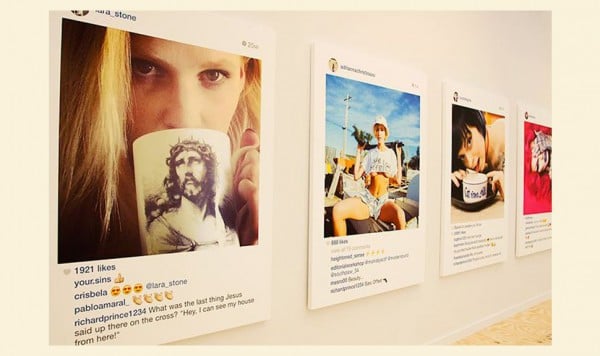
The Suicide Girls's print is just a grab for air time.

Artnet News

When Paddy Johnson wrote her piece “Richard Prince Sucks,” a critique of Prince’s 2014 show at Gagosian, in which his series of Instagram works was presented, she set out to denounce the work for being “vapid” and nothing but a cash grab.
With the recent exhibition of the Instagram works at Frieze New York, there has been much consternation by writers on various sites about Prince’s most recent appropriation practice, whereby he takes the Instagram posts of other people, comments on them, prints them out as his own work, and sells them for roughly $90,000. One site, SuicideGirls, has even printed out their own version of a Prince work (made from their image, which Prince had appropriated) and is selling it for $90 (see Payback for Richard Prince as Models Reappropriate Stolen Instagram Images and Sell Them for $90). Here, in light of recent developments, Johnson, in an interview, revisits the issues and explores some of the newer developments that have arisen.

artnet News: What do you think of what the Suicide Girls have done, in printing their own Instagram image the way that Richard Prince had printed it, and selling it for $90 as opposed to $90,000?
Paddy Johnson: So, they are selling the same prints for 90 bucks—that’s just a response. It knocks the value down by like a level of magnitude. But they don’t have the same distributor—meaning, Gagosian, as a luxury brand, can command a lot higher prices than an online community of soft-core pin up models. (See Who Are the Suicide Girls? Inside the Nude Pin-Up Community that Trolled Richard Prince.)
But when you say it “knocks the value down,” that seems to suggest you think the Suicide Girls’s and Prince’s works are one and the same. Do you think that?
No.
It could be said that Prince appropriated their image. But it seems their act wasn’t one of appropriation because it was their image to begin with. What is the distinction between the two to you—Prince’s work and theirs?
Context. Theirs is a comment on what somebody else has done with their image. His is a tired continuation of his older appropriation work.
Context was a big part of why Richard Prince’s appropriation in the first place made waves. He’s an early appropriation artist. He’s said he was drawn to images “he didn’t quite believe”—basically, the uncanny—and the rephotographing of the work was meant to make the work more unbelievable, more uncanny. And I think it worked, partly because with the ad copy erased it became very hard to identify the market this image belonged in. And that’s how we understand things. These Instagram images are just headlines about sale prices, so there’s very little confusion about how to place this work. That makes it a lot less interesting.
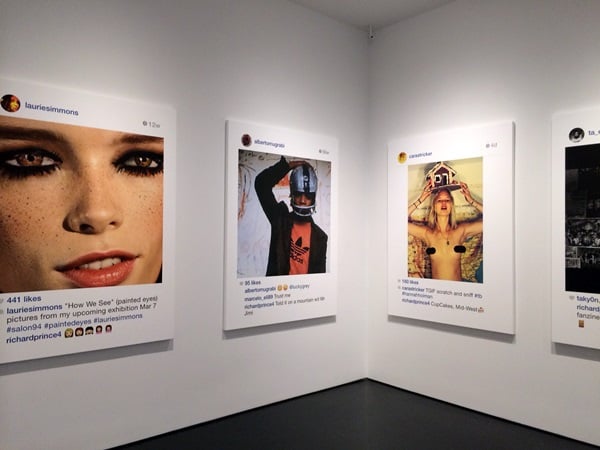
Installation view of Richard Prince, “New Portraits,” at Gagosian
Photo: Paddy Johnson.
What did you think about the recent articles on PetaPixel and Business Insider in which people seemed to be getting upset over Prince “stealing” the images and selling the works for $90,000 or $100,000? In the PetaPixel article, the writer called him a “thief” for just about all the work he’s ever done. I thought Donn Zaretsky captured it well on his Art Law blog when, about the stories, he wrote, “Breaking News: Richard Prince is an appropriation artist.”
Taking down all of the appropriation that he’s ever done is a little too much. With the Patrick Cariou stuff, he’s obviously manipulated the original images significantly—they’re at a much different scale, there’s not even a question about the presence of an artistic vision. Presenting the two images (Prince’s and Cariou’s) side-by-side like that (the way they were consistently shown in the media) is misleading. It suggests that the two images were the same size and that scale means nothing. And that’s obviously not the case.
I dismissed a lot of his work too in the first review that I wrote (see Richard Prince Sucks). But the objective wasn’t to discredit the value of the work then, but to question the merit of applying a very similar approach today. I don’t think you can just apply the criticism of his Instagram series to all appropriation ever and say, ‘Look you jerk, you’re stealing stuff. It’s a problem.’
So you’re not against all appropriation?
I am absolutely not against all appropriation. I’m just against dumb art.
Let’s come back for a moment to your comments about the Prince works in which he appropriated the Cariou photographs and how those are different from these Instagram works.
There’s actual paint on those. He’s manipulated the image. He’s added a guitar to one of them. Those alterations seem minimal in a cropped 320-pixel-wide reproduction, but one look at the massive Prince paintings in the gallery, and you know they are a significant departure from Cariou’s tiny photos. It’s barely even appropriation.
The fact that it’s being shoved into that category, so that Allen Murabayashi over at PetaPixel can kick him in the face isn’t fair.
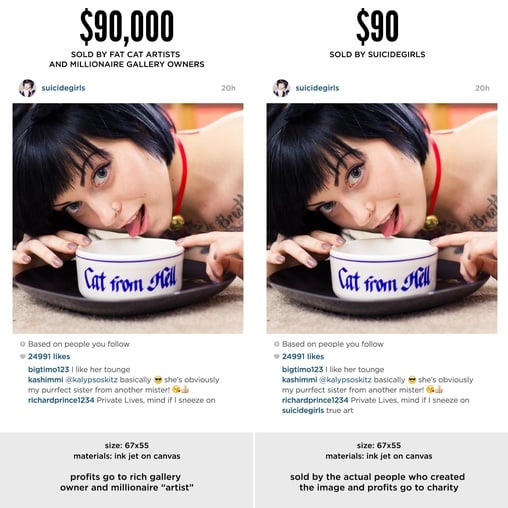
Photo: Suicide Girls.
So, the Instagram series shouldn’t even be considered appropriation?
Well, I would have to look at the legal definition, but his Instagram photos are appropriation. To be clear, I’m glad that the rules in the art world are loose enough that we don’t have the same restrictions as say the music industry where you can’t sample like three beats of a song before you’re infringing on somebody else’s copyright.
That actually does create a restriction on creativity. So I think there’re two different issues here. Because there’s the conversation about the Instagrams themselves, and their value as works of art, versus the conversation about appropriation, which isn’t necessarily tied so directly.
What about Prince’s act of putting his own comment on the Instagram post before he prints it out. Should that be considered ‘modification’ in the way a daub of paint was considered part of Prince’s modification of Cariou’s images?
It’s barely a modification. It’s a comment. Prince isn’t trying to make unique or special comments. They are entirely commonplace. I suppose that’s not too different than rephotographing the Marlboro Man in that what he did anyone could do, but at least then the images kind of vibrate without the ad copy. Without the platform and the extended comment threads, how are these images changed? Well, they are printed.
It’s one thing to reproduce something when very few artists are doing that and open up the field for artists to do whatever the hell they want. It’s another thing to do the same thing 30 years later in a culture where everyone copy-and-pastes and takes screen shots.
He’s not doing anything unique—in fact, he’s indistinguishable from any other troll on the web.
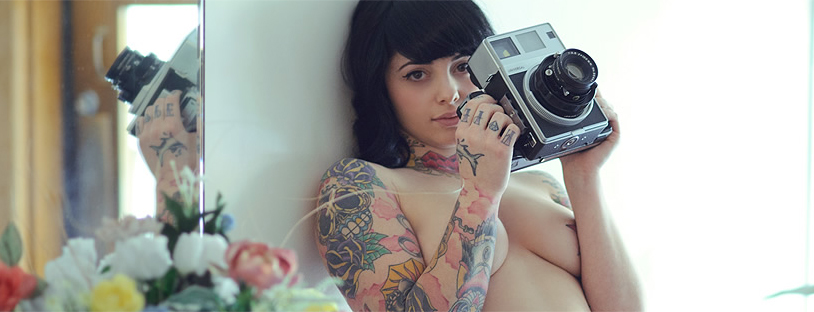
Photo: Suicide Girls.
How does this compare to what the Suicide Girls are doing now?
The Suicide Girls’s gesture is both marketing and a comment on the market. I like that they are taking control of their image because I do think that work is sexist—he always represents images of hot young girls—and it bothers me how little that comes up in these conversations.
But generally, it’s not a very deep statement. Basically, the Suicide Girls have printed their images for 90 bucks, which seems probably in line with the market they might have for their own schwag and promised to donate it to charity. So is the statement “I can make money on my image too”? “Look at how little this work is actually worth”? or “I’m going to infuse art with the higher moral imperative I know art is somehow supposed to impart, even if it’s just a nebulous abstract canvas”? Probably it’s all three, but mostly it feels like a grab for air time.
To me that’s just not that interesting. What was interesting, from an art and marketing perspective, was when Gagosian put on that Damien Hirst retrospective that was really a fire sale. That’s a kind of market manipulation that almost nobody saw, but was definitely there.
The act of the Suicide Girls does not demonstrate a deep understanding of the power of creativity. Real creativity breaks patterns of thinking and helps us see things in an entirely different light. It can be very empowering.
This feels like a conversation within different ideological camps—it feels like class warfare. Certainly it doesn’t challenge the structures and systems we’re already working within.
If the Suicide Girls were able to somehow make a movement out of their $90 charity act, then we’d be having a different conversation. But in the world of Prince and the Suicide Girls, nobody’s really doing anything other than staking out their territory.
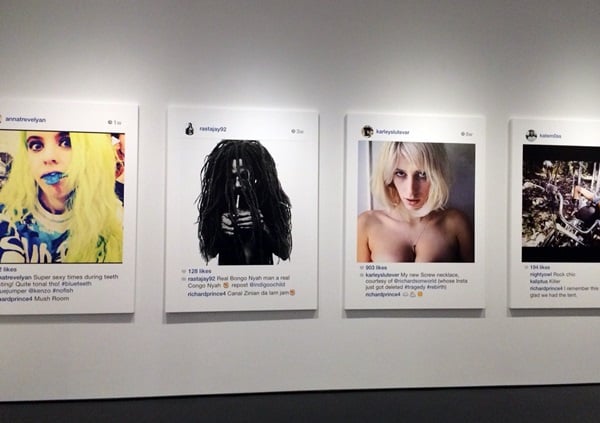
Installation view of Richard Prince, “New Portraits,” at Gagosian
Photo: Paddy Johnson